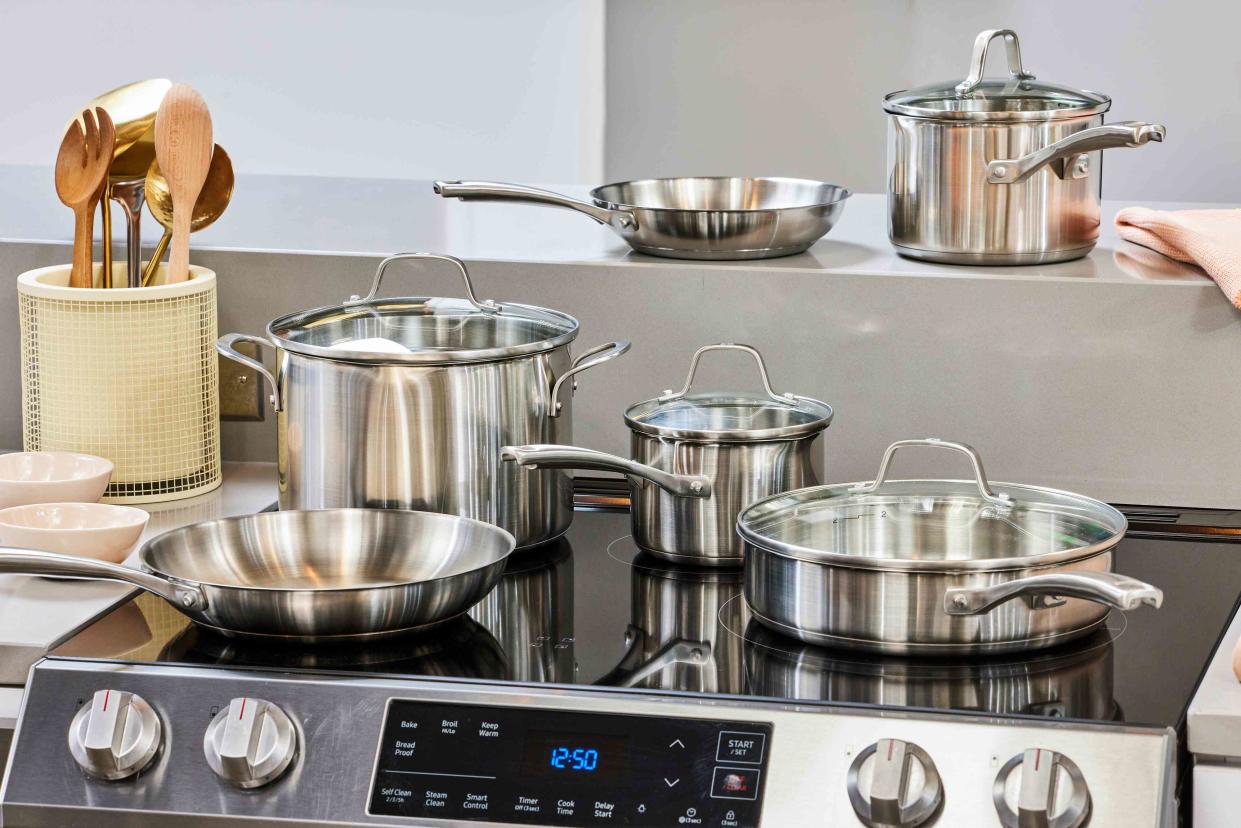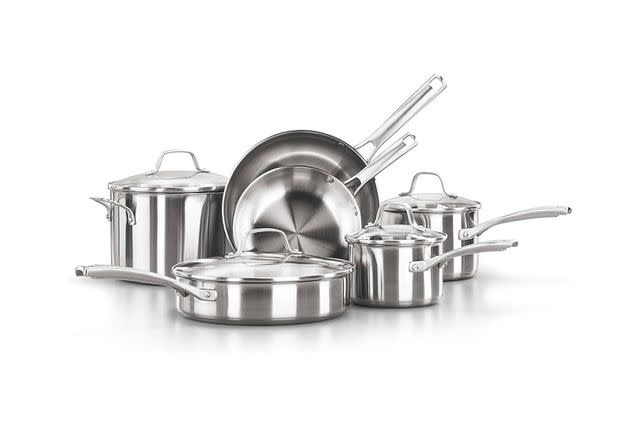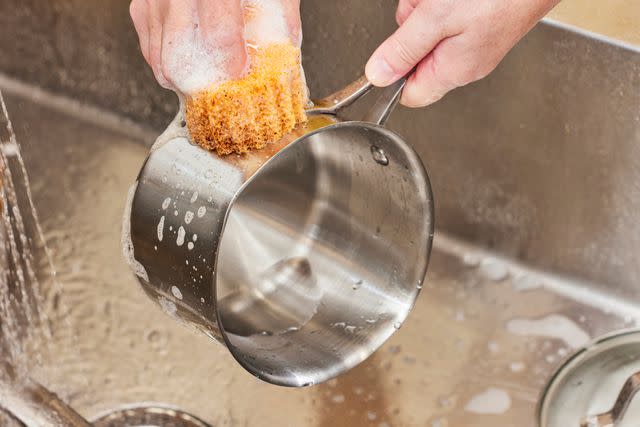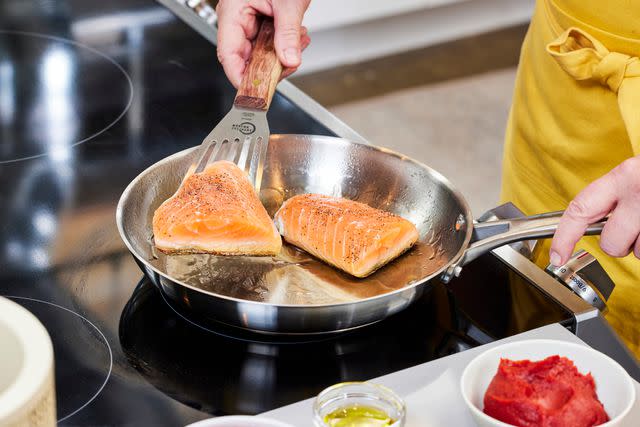I Follow a Mediterranean Diet & This Is My Favorite Stainless Steel Cookware Set
Dotdash Meredith and Yahoo Inc. may earn commission or revenue on some items through the links below.
Is buying a cookware set a good choice over individual pieces? Here’s a chef’s take.

EatingWell / Nick Simpson
Reviewed by Dietitian Brierley Horton, M.S., RD
I’ll admit that I have traditionally been against cookware “sets.” The idea that any one-fits-all option, chosen by someone else, will meet my cooking needs feels like a trick.
So when I was asked to test cookware sets, I started to mentally prepare. Part of that prep meant thinking about my cookware usage—and, well, I was shocked to realize that I use the exact items in the Calphalon Classic Stainless Steel Cookware set all the time!
And I mean every piece.
I cook dinner at home 26 days a month (at least!), and I follow a Mediterranean diet, so I use every pot, pan and lid frequently. Whether it’s grain bowls or seared fish, steamed vegetables or the occasional pasta, it takes about six pots and pans to keep things going, especially if I don’t want to clean them constantly. The little overage permits me to lay off dishwashing for one meal, leaving me enough to work with for another meal and some rest. Then I start all over.
Even though I liked the components of the Calphalon Classic Stainless Steel Cookware Set, that was not lol enough to convince me to recommend it. I needed to cook with it, wash it and (don’t laugh!) carry it around a little to decide if I truly could crown it the “Best Stainless Steel Cookware Set.”
Then I had to write out my thoughts and analyze my insights before concluding that the Calphalon set was the superior choice.
Calphalon Classic 10-Piece Stainless Steel Cookware Set

What we like: The set's variety of sizes allows for cooking small and large quantities of food.
What to know: There are no lids for the frying pans.
Pieces Included: 8- and 10-inch fry pans, 1.5- and 2.5-quart saucepans with lids, 3-quart sauté pan with lid, 6-quart stockpot with lid | Material: Stainless steel | Induction-Compatible: Yes | Oven-Safe: Yes, to 450˚F (without lids) | Dishwasher-Safe: Yes
With price tags often in the hundreds, stainless cookware sets are a financial commitment and take up substantial real estate in your kitchen. Stainless steel cookware, in particular, has a reputation for its durability, heat distribution and retention, and clean look; however, those are not guaranteed qualities and are not the only features that make a set a truly useful purchase.
Here are the features that made this set shine.
The Design
The clear tempered glass lids were the first thing that differentiated the Calphalon set. Though it may seem trivial, seeing the progress of your rice, grains and simmering soups is extremely helpful. If you are steaming vegetables and looking for a color cue, it's hard to see through a stainless lid, and constantly removing the top to check the progress slows the process of steaming overall.
The second thing I loved was the lightly textured handles. The Mediterranean diet calls for olive oil in most recipes, and I cannot keep it off my hands. The brushed steel texture of the handles makes juggling pans much easier.
Thoughtful design elements in the Calphalon set reduce excess work in the kitchen and the need for some extraneous tools. Each saucepan and stockpot feature pour spouts, and their corresponding lids have drain spouts, making two functions easier and obviating the need for a funnel and colander for some situations. Clear measurement marks on the interior of the saucepans make it easy to fill them directly and accurately without a measuring cup. I would have loved a lid for each of the skillets and a helper handle on the sauté pan. But also the variety of pan and pot sizes made it easy to cook for just me some nights.
Cooking Performance
To assess the performance of the Calphalon set, I tested multiple pans in tasks aligned with their size and purpose. Curiously, the instructions for these pans mirror those for nonstick pans—cooking temperatures should not exceed medium for prolonged periods of time. Historically, I would go medium-high for almost everything, but I honored the directions, and surprisingly they were right! I didn’t need that high heat to achieve high-heat results. The impact-bonded stainless steel base with an aluminum core is a terrific conductor of heat, and it worked beautifully with my induction range.
I tested the 10-inch skillet first to evaluate evenness, browning and sticking. I cooked two skin-on salmon fillets and found the medium setting could build enough heat to sear the skin nicely and get it crisp; when I flipped them, the pan browned the top beautifully. I also used a metal fish spatula without incurring scratches, which is a definite bonus. For those who like to finish their salmon in the oven, this set is oven-safe to 450˚F (without lids). However, these pans are not broiler-safe.
I browned butter in the 1.5-quart saucepan to test for hot spots and to see if the spouts were as helpful as they looked. Browning the butter was very easy, even with the lid on to hold in any steam, thanks to even heating across the base of the pot and simple pouring. The browned butter also proved to be a delightful sauce for the salmon (and a side of steamed asparagus).
Seven Spice Jollof Rice, a popular West African dish, was the final cooking challenge, allowing me to see if the pan would stain or have issues with stuck-on rice. (This rich and spicy tomato-based dish is best made in a 3-quart sauté pan.) During a portion of the testing, when I browned the tomato paste and herbs, there was a bit of a fond on the bottom of the pan. To my delight, the film released easily when the stock was added and didn’t cause any issues during clean-up.
Ease of Cleaning
This entire set is dishwasher-safe, but I hand-washed the pans to see if it was easy. Often, I find my larger pans, even dishwasher-safe ones, end up in the sink and get hand-washed so I can get more dinnerware in the machine. Warm, soapy water, a gentle sponge and absolutely no elbow grease made these pans look nearly new. The olive oil I used to cook the salmon did discolor the skillet mildly, but I expected them to patina a bit after a sear.
The Bottom Line
So, is getting a stainless steel cookware set a better choice than purchasing individual pieces? Absolutely. At a price of $200 per set, an average of $20 per piece, this is a steal. Each piece would be far more expensive if purchased individually, and the ability to make several meals between washings is a total win. If you have a household that expands and contracts with sports, travel and holidays, the variously sized pots and pans are extremely useful.
I also found that, as a lover of the Mediterranean diet, this stainless steel set was perfect for preparing each of the healthy dishes I rely on: delicious lentils (2.5-quart saucepan), hearty pasta dishes (6-quart stock pot) and quick-cooking oats (1.5-quart saucepan).
We Also Considered
Pieces Included: 1.5- and 3-quart saucepans with covers, 3.5-quart sauté pan with cover, 8-quart stockpot with cover, 8- and 10-inch skillets, 20-centimeter steamer insert with cover | Material: Stainless steel | Induction-Compatible: Yes | Oven-Safe: Yes, to 550˚F | Dishwasher-Safe: Yes
We also tested this 12-piece Cuisinart set and liked it a lot. It is a larger set thanks to a handy steamer insert and lid. I loved the helper handle on the sauté pan and the interchangeable lids that also fit the skillets. But this set was $100 more than the Calphalon set. Additionally, the olive oil from the salmon baked on the surface, much like spray oils will do. With a lot of effort scrubbing the skillet for 10 minutes, I got the pan pretty clean, but the issue was an overall disappointment.
Common Questions
How do you clean stainless steel cookware?
Although the Calphalon set is technically dishwasher-safe, I recommend hand-washing. It will extend the useability of your cookware, as the water and detergent in dishwashers can wear away the surface of each piece.
The first rule of cleaning: Never put your hot pan under water because it can warp and damage the pan. Instead, remove any food and loose debris then let it cool slightly and wash the pans with warm water and mild detergent. If you find some sticking that won’t come away easily, add water and a little dish soap to the pan, put it back on the stovetop, bring it to a boil then let it cool and wash it again.
For really stubborn stains, a little baking soda, detergent, and a small amount of water can safely be used to scrub the pan. A key element of washing is drying. Make sure to dry your pans fully using a soft cloth after each use. This will prevent watermarks and any damage sitting water can inflict.
The bottom of a pan is often forgotten, and you should address this area with the same care instructions as the inside of the pan, minus scrubbing.

EatingWell / Nick Simpson
How do you cook with stainless steel cookware?
I always recommend reading the manufacturer's instructions before using any cookware to ensure you approach it properly; however, I found that cooking with the Calphalon Classic set was more about consistency and less about fire. For searing, allow the pan to preheat on medium for 90 seconds before adding your ingredients, and then adjust the heat if needed. If you want a hard sear, a medium-high preheat is fine as long as you move back to medium after 90 seconds. For all other cooking tasks, including boiling liquids, medium heat is excellent, as it relies more on the integrity of the pan’s construction to conduct the heat properly.

EatingWell / Nick Simpson
How do you season stainless steel cookware?
Seasoning stainless steel cookware is a controversial topic. The “yes” camp adheres to the idea that, like cast iron, seasoning stainless skillets will create a nonstick surface, while the “no” camp considers seasoning an unnecessary step.
If you want to season your pans, here are the steps you’ll want to take:
Wash your pan thoroughly to remove all dirt and debris, then dry it with a soft cloth until no moisture is present. Add 2 tablespoons of canola oil; swirl to coat (even up the sides). Place your pan over medium heat until the oil begins to smoke, about two to three minutes, then remove from the heat and cool completely. Wipe away any excess oil from the pan and you will be ready to cook. This should be done at least two times a year but can be done more frequently based on your usage. After your pan is seasoned, you should no longer use soap to clean it. To avoid damaging your seasoning layer, you should only rinse it with hot water and wipe it dry after each use.
Is stainless steel cookware safe and non-toxic?
According to Carolyn Williams, Ph.D., RD, culinary nutrition expert and cookbook author, “Uncoated stainless steel pans are one of the best choices for safer, everyday cookware. There are potential risks when using pans b that have nonstick coatings. This is because some nonstick coatings are created using chemicals known as PFAS, which are linked to issues with fertility, hormone imbalances and some cancers.”
The Calphalon stainless steel cookware set is not only my recommendation for the best stainless steel cookware set, but it is also nontoxic.
Our Trusted Expertise
Tiffany Vickers Davis tested each of the cookware sets featured in this article. She is a chef, writer and food entrepreneur with over 25 years of experience. Having started in high-profile restaurant kitchens, Tiffany owns and operates a fresh-prepared meal company that ships nationally. Before starting her company, she was the test kitchen director at Cooking Light magazine, testing hundreds of products during her 14-year tenure with the brand. She loves a great piece of seared fish, a light lemon sauce, and some steamed vegetables. She does not season her stainless pans and realizes she has been wrong for a long time on the value of a full cookware set versus individual pieces.
This article was edited by Brierley Horton, M.S., RD, senior commerce editor who has 15 years of experience reporting, writing and editing nutrition and health content. She also is a fan of stainless steel cookware, though she likes to work in a few pieces of ceramic cookware here and there.
Read the original article on Eating Well.
